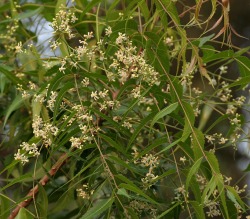Neem

In India, neem tree is variously known as "Divine Tree," "Heal All," "Nature's Drugstore," "Village Pharmacy" and "Panacea for all diseases". It is an ancient belief that neem growing inside the house can keep the surrounding air clean of impurities and thereby control environmental pollution. Neem is ecologically very special. It can tolerate very high levels of pollution and has the capacity to recover even if most of its foliage is dropped. Neem trees can survive up to from 200 to 300 years, if not cut down.
Neem has relatively high efficiency of CO2 fixation. It can fix more than 14 umole of CO2 per m2 Sec. With a thick foliage canopy and a very high leaf surface area, it provides a good option for maximum CO2 fixation and providing a shield against other pollution components particularly SO2. It was no coincidence that Emperor Ashoka, in the 3rd century before Christ, commanded that Neem be planted along the road highway and roads along with other perennials, Tamarindus indica and Madhuca Latifolia.
Products made from neem have proven medicinal properties, being anthelmintic, antifungal, antidiabetic, antibacterial, antiviral, anti-fertility, and sedative. It is considered a major component in Ayurvedic medicine and is particularly prescribed for skin disease. All parts of the tree (seeds, leaves, flowers and bark) are used for preparing many different medical preparations.
Medical Benefits
- Part of the Neem tree can be used as a spermicide
- Neem oil is used for preparing cosmetics (soap, shampoo, balms and creams, for example Margo soap), and is useful for skin care such as acne treatment, and keeping skin elasticity.
- Neem oil has been found to be an effective mosquito repellent.
- Neem derivatives neutralise nearly 500 pests worldwide, including insects, mites, ticks, and nematodes, by affecting their behaviour and physiology. Neem does not normally kill pests right away, rather it repels them and affects their growth. As neem products are cheap and non-toxic to higher animals and most beneficial insects, it is well-suited for pest control in rural areas.
- Besides its use in traditional Indian medicine the neem tree is of great importance for its anti-desertification properties and possibly as a good carbon dioxide sink.
- Practitioners of traditional Indian medicine recommend that patients suffering from chicken pox sleep on neem leaves.
- Neem gum is used as a bulking agent and for the preparation of special purpose food (for diabetics).
- Aqueous extracts of neem leaves have demonstrated significant antidiabetic potential.
- Traditionally, teeth cleaning was conducted by the chewing of slender neem branches. Neem twigs are still collected and sold in markets for this use, and in India one often sees youngsters in the streets chewing on neem twigs.
- A decoction prepared from neem roots is ingested to relieve fever in traditional Indian medicine.
- Neem leaf paste is applied to the skin to treat acne.
Where do I get it?
Resources
http://en.wikipedia.org/wiki/Neem
http://www.neemfoundation.org
Neem has relatively high efficiency of CO2 fixation. It can fix more than 14 umole of CO2 per m2 Sec. With a thick foliage canopy and a very high leaf surface area, it provides a good option for maximum CO2 fixation and providing a shield against other pollution components particularly SO2. It was no coincidence that Emperor Ashoka, in the 3rd century before Christ, commanded that Neem be planted along the road highway and roads along with other perennials, Tamarindus indica and Madhuca Latifolia.
Products made from neem have proven medicinal properties, being anthelmintic, antifungal, antidiabetic, antibacterial, antiviral, anti-fertility, and sedative. It is considered a major component in Ayurvedic medicine and is particularly prescribed for skin disease. All parts of the tree (seeds, leaves, flowers and bark) are used for preparing many different medical preparations.
Medical Benefits
- Part of the Neem tree can be used as a spermicide
- Neem oil is used for preparing cosmetics (soap, shampoo, balms and creams, for example Margo soap), and is useful for skin care such as acne treatment, and keeping skin elasticity.
- Neem oil has been found to be an effective mosquito repellent.
- Neem derivatives neutralise nearly 500 pests worldwide, including insects, mites, ticks, and nematodes, by affecting their behaviour and physiology. Neem does not normally kill pests right away, rather it repels them and affects their growth. As neem products are cheap and non-toxic to higher animals and most beneficial insects, it is well-suited for pest control in rural areas.
- Besides its use in traditional Indian medicine the neem tree is of great importance for its anti-desertification properties and possibly as a good carbon dioxide sink.
- Practitioners of traditional Indian medicine recommend that patients suffering from chicken pox sleep on neem leaves.
- Neem gum is used as a bulking agent and for the preparation of special purpose food (for diabetics).
- Aqueous extracts of neem leaves have demonstrated significant antidiabetic potential.
- Traditionally, teeth cleaning was conducted by the chewing of slender neem branches. Neem twigs are still collected and sold in markets for this use, and in India one often sees youngsters in the streets chewing on neem twigs.
- A decoction prepared from neem roots is ingested to relieve fever in traditional Indian medicine.
- Neem leaf paste is applied to the skin to treat acne.
Where do I get it?
Resources
http://en.wikipedia.org/wiki/Neem
http://www.neemfoundation.org
